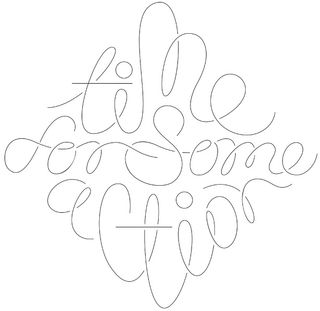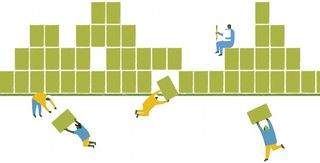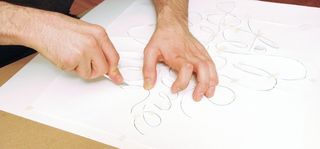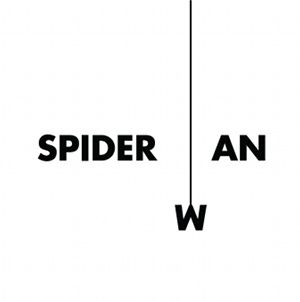Project diary: Science into art
When Belgian design agency Soon was asked to produce a creative annual report for a life sciences client, its approach proved to be anything but conventional
Belgian based biotech company Ablynx asked Soon to create its annual report after seeing a previous project it had done for life sciences institute VIB, which relied heavily on chalk drawings. Ablynx initially wanted Soon to do something similar, but the agency had other ideas.
THE DESIGN BRIEF
Jim Van Raemdonck
Belgian biotech company Ablynx approached us and asked if we wanted to do its annual report. It had already seen a project of ours for life sciences institute VIB’s 15th birthday event, which had been created using only chalk and a large blackboard. The project was accompanied by a commemorative box containing nine books with 200 chalk drawings inside. Ablynx wanted its annual report to be created in a similar style, making us the natural choice of studio.
We gave the company a price and a budget, which it agreed to. We then set about learning as much about the client as possible, making sure we understood exactly what was to be included in the brief. Before properly starting, we set up a project management team and agreed a schedule, then gathered all the assets we needed from Ablynx for the project, keeping all the organisation and schedules in a central location using Basecamp.

We like to start every project with a mood book containing images, colours and examples of similar projects that we think have worked well. Next we work on some sketches and layouts to show the client, so it understands the rationale behind our thinking. A teacher of mine once said you sometimes have to stand on the shoulders of giants to get bigger and better – in other words, it’s okay to steal ideas as long as you improve on them by creating something original and memorable of your own. When you’re creating infographics using conventional methods there’s a limit to what you can do, but then we hit on the idea of turning the infographics into physical objects – as far as I’m aware, it’s never been attempted before.
WORK IN PROGRESS
Phoebe De Corte
When we first presented Ablynx with our idea for the infographics, the response wasn’t very enthusiastic – chiefly because the initial sketches hadn’t really given the impression of scale we were trying to convey. After all, Ablynx was expecting something centred on chalk-based illustrations, not super-sized physical infographics. We went to great lengths to keep the client onside – even giving Ablynx daily updates online so it knew how the project was progressing.

Because we were going to physically build the infographics using MDF, recycled wood and paint, one of our biggest challenges was ensuring they truly represented the facts and figures given to us. The information we were given for one particular infographic changed twice while we were making it, so we had to rebuild it twice to make absolutely sure everything was done to the right scale.
Another challenge was finding a space large enough to actually photograph the infographics, on a very limited budget. We spent quite a long time researching possible locations, but ended up shooting some of the smaller ones in our studio, and others in the studios of fellow graphic design agency Skinn. The biggest infographic was shot at another client of ours – Ghent Museum – using a space that was temporarily empty, giving us just two hours to get the photoshoot done. Logistically, getting the objects to the right location at the right time was tricky, as we had to hire trucks to move them around. And in trying to give the infographics a sense of scale, on many of our location shoots we needed to have someone there, standing next to the objects too.

CONCLUSION
Jim Van Raemdonck
One of the most enjoyable parts of the project was seeing our initial ideas turn from rough sketches into Illustrator graphics and then into physical objects. It was really exciting seeing each piece come together for the first time. I have to admit I was very nervous about how it would all turn out in the end, and although there were things we could have done better, the reaction from everyone who saw it was fantastic.

Ablynx was certainly happy with the end result and the feedback on its website has been very positive. We also managed to pick up a lot of followers after publishing the project on Behance. Perhaps the most satisfying thing is that we were asked to create a truly creative annual report – and we met the brief to the letter.
Discover 8 free tools for creating infographics, over at Creative Bloq.
Get the Creative Bloq Newsletter
Daily design news, reviews, how-tos and more, as picked by the editors.

Thank you for reading 5 articles this month* Join now for unlimited access
Enjoy your first month for just £1 / $1 / €1
*Read 5 free articles per month without a subscription

Join now for unlimited access
Try first month for just £1 / $1 / €1
The Creative Bloq team is made up of a group of design fans, and has changed and evolved since Creative Bloq began back in 2012. The current website team consists of eight full-time members of staff: Editor Georgia Coggan, Deputy Editor Rosie Hilder, Ecommerce Editor Beren Neale, Senior News Editor Daniel Piper, Editor, Digital Art and 3D Ian Dean, Tech Reviews Editor Erlingur Einarsson and Ecommerce Writer Beth Nicholls and Staff Writer Natalie Fear, as well as a roster of freelancers from around the world. The 3D World and ImagineFX magazine teams also pitch in, ensuring that content from 3D World and ImagineFX is represented on Creative Bloq.
